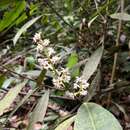en
names in breadcrumbs


Myrsinoideae is a subfamily of the family Primulaceae in the order Ericales. It was formerly recognized as the family Myrsinaceae, or the myrsine family, consisting of 35 genera and about 1000 species. It is widespread in temperate to tropical climates extending north to Europe, Siberia, Japan, Mexico, and Florida, and south to New Zealand, South America, and South Africa.
Plants are mostly mesophytic trees and shrubs; a few are lianas or subherbaceous. Their leathery, evergreen leaves are simple and alternate, with smooth margins and without stipules. They are often dotted with glands and resinous cavities. The latter may take the form of secretory lines.
The plants are mostly monoecious, but a few are dioecious. Their small flowers are arranged in racemose terminal clusters, or in the leaf axils. The flowers have four or five sepals and petals. The floral envelope (perianth) has a distinct calyx and corolla. The calyx is regular and polysepalous. The nonfleshy petals of the corolla are more or less united, closely overlapping. The four or five stamens are usually isomerous with the perianth. The carpel has one style and one stigma, with the ovary unilocular, superior or semi-inferior.
The one-seeded, indehiscent fruit is a thin-fleshed berry or drupe.[1] North American species are the marlberry (Ardisia escalloniodes) and the Florida rapanea (Rapanea punctata).
Plants in the subfamily have few economic uses. A few genera, such as Ardisia, Cyclamen, Lysimachia, and Myrsine, are grown as ornamental plants, especially Ardisia crispa and Myrsine africana. One species, Ardisia japonica (Chinese: 紫金牛; pinyin: zǐjīn niú), is one of the 50 fundamental herbs in traditional Chinese medicine.
In the APG III system and onwards, the Myrsinaceae were not recognized, but were sunk into Primulaceae, which in that system is circumscribed very broadly.
The following genera, traditionally categorized in Primulaceae sensu lato, should, according to Källersjö et al. (2000), belong to the Myrsinoideae (the clade of Myrsinaceae s. l.): Anagallis, Ardisiandra, Asterolinon, Coris, Cyclamen, Glaux, Lysimachia, Pelletiera and Trientalis.
Myrsinoideae is a subfamily of the family Primulaceae in the order Ericales. It was formerly recognized as the family Myrsinaceae, or the myrsine family, consisting of 35 genera and about 1000 species. It is widespread in temperate to tropical climates extending north to Europe, Siberia, Japan, Mexico, and Florida, and south to New Zealand, South America, and South Africa.
Plants are mostly mesophytic trees and shrubs; a few are lianas or subherbaceous. Their leathery, evergreen leaves are simple and alternate, with smooth margins and without stipules. They are often dotted with glands and resinous cavities. The latter may take the form of secretory lines.
The plants are mostly monoecious, but a few are dioecious. Their small flowers are arranged in racemose terminal clusters, or in the leaf axils. The flowers have four or five sepals and petals. The floral envelope (perianth) has a distinct calyx and corolla. The calyx is regular and polysepalous. The nonfleshy petals of the corolla are more or less united, closely overlapping. The four or five stamens are usually isomerous with the perianth. The carpel has one style and one stigma, with the ovary unilocular, superior or semi-inferior.
The one-seeded, indehiscent fruit is a thin-fleshed berry or drupe. North American species are the marlberry (Ardisia escalloniodes) and the Florida rapanea (Rapanea punctata).
Plants in the subfamily have few economic uses. A few genera, such as Ardisia, Cyclamen, Lysimachia, and Myrsine, are grown as ornamental plants, especially Ardisia crispa and Myrsine africana. One species, Ardisia japonica (Chinese: 紫金牛; pinyin: zǐjīn niú), is one of the 50 fundamental herbs in traditional Chinese medicine.
In the APG III system and onwards, the Myrsinaceae were not recognized, but were sunk into Primulaceae, which in that system is circumscribed very broadly.
Myrsinoideae es una extensa subfamilia de árboles o arbustos del orden Ericales que agrupa en 48 géneros con cerca de 1000 especies. En la actualidad existen discrepancias taxonómicas en la comunidad científica con esta subfamilia. El sistema APG III la ha clasificado como Myrsinoideae, una subfamilia de las primuláceas. El género tipo es: Myrsine L.[1]
Son arbustos o árboles o plantas herbáceas; plantas hermafroditas, dioicas, androdioicas o polígamas. Hojas alternas, simples, con puntuaciones pelúcidas anaranjadas, cafés o negras, punteadas (redondas) o lineares (alargadas); sésiles o pecioladas, estipuladas. Inflorescencias glomeruladas, capituladas o paniculadas, flores unisexuales o bisexuales, actinomorfas; cáliz de 3–6 miembros, los sépalos libres o connados en la base, de prefloración valvada, imbricada o quincuncial, punteados, persistentes; corola gamopétala, rotácea o campanulada, los lobos 3–6, casi libres o connados en la base, de prefloración valvada, imbricada, quincuncial o contorta, con marcas punteadas o lineadas; estambres en igual número que los lobos de la corola y opuestos a ellos, filamentos obsoletos (Myrsine), libres o connados en la base formando un tubo, libres o adnados a la corola; ovario súpero, 1-locular, con placentación basal o libre central, los óvulos pocos a numerosos, en 1, 2 o múltiples series, estilo simple u obsoleto. Fruto drupáceo; semilla 1.[2]
Una subfamilia pantropical y subtropical con unos 30 géneros y más de 100 especies. La familia tiene muchos problemas taxonómicos debido a sus flores pequeñas, frecuentemente unisexuales y su rareza, de ahí el gran número de sinónimos.
La subfamilia se encuentra en las zonas tropicales templadas, habiéndose extendido hasta el norte de Japón, Florida y Nueva Zelanda.
Myrsinoideae es una extensa subfamilia de árboles o arbustos del orden Ericales que agrupa en 48 géneros con cerca de 1000 especies. En la actualidad existen discrepancias taxonómicas en la comunidad científica con esta subfamilia. El sistema APG III la ha clasificado como Myrsinoideae, una subfamilia de las primuláceas. El género tipo es: Myrsine L.